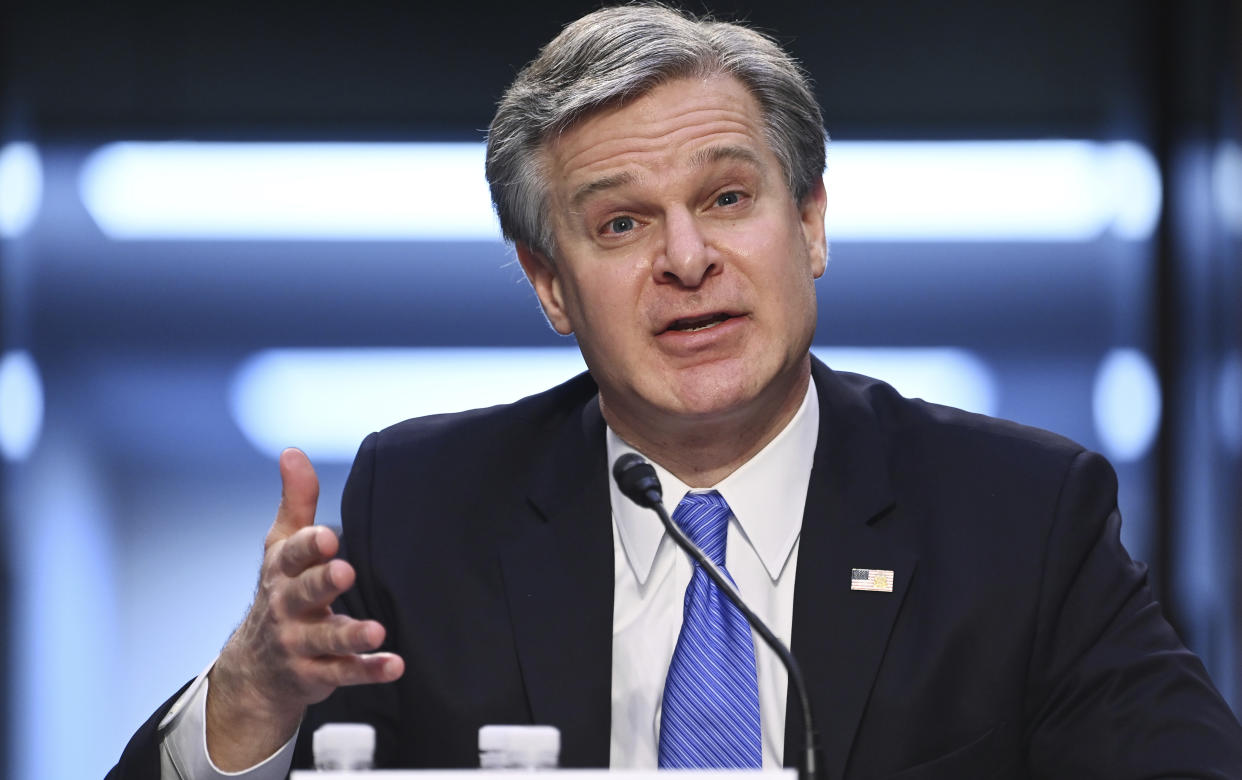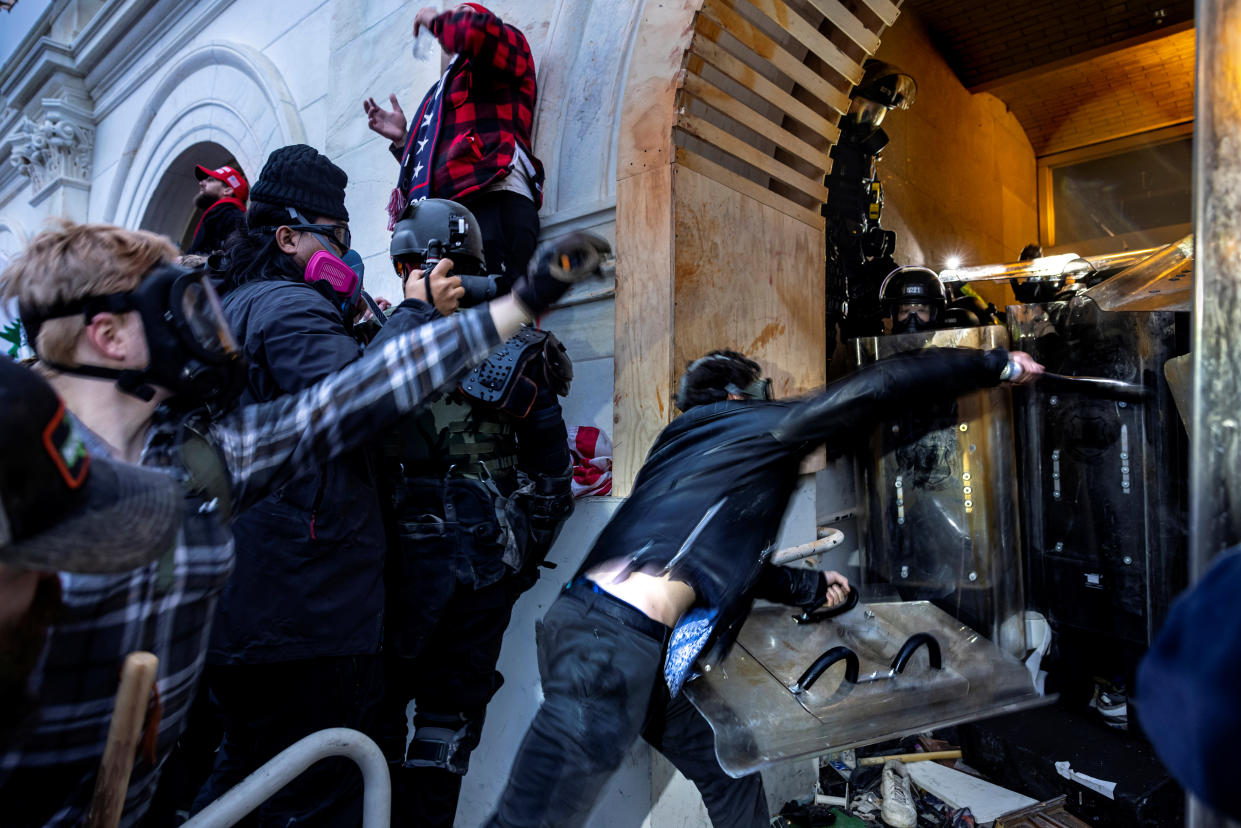FBI Director Christopher Wray pressed on lack of warning before Capitol attack
Pressed on what federal authorities knew about the threat of violent extremism before the attack at the U.S. Capitol, FBI Director Christopher Wray told the Senate Tuesday that he did not see an agency report issued a day before the riot that described specific threats of violence in Washington.
The admission puts Wray in the company of several top law enforcement officials in Washington who’ve said that they did not see a memo detailing the threats before the deadly siege at the Capitol on Jan. 6.
Wray testified before the Senate Judiciary Committee that the Jan. 5 report from the FBI office in Norfolk, Va., was disseminated and communicated with the FBI’s law enforcement partners, including the U.S. Capitol Police. The “raw, unverified” information, Wray said, was emailed to the agency’s joint terrorism task force, communicated verbally at a command post briefing in Washington that included Capitol and D.C. Metro Police and posted online on a portal that’s available to law enforcement across the country.
“I didn't see that report until some number of days after [Jan. 6],” Wray said. “But again, that information was passed, within 40 minutes to an hour, to our partners, including the Capitol Police, including Metro PD, in not one, not two, but three different ways.”
But when asked by Sen. Dianne Feinstein, D-Calif., why some law enforcement officials weren’t aware of the warnings, Wray said he didn’t “have a good answer for that.”

Wray faced multiple questions Tuesday about the FBI’s handling of the situational information report, which was first made public by the Washington Post on Jan. 12. His remarks came a week after former Capitol Police Chief Steven Sund testified before members of the Senate Homeland Security and Rules committees that he did not see the report and had only recently been informed that the Capitol Police received it, Yahoo News’ Caitlin Dickson reported.
Michael Stenger and Paul Irving, former sergeants-at-arms for the Senate and House, said they also didn’t receive the report.
“In a perfect world, we would have taken longer to be able to figure out whether it was reliable,” Wray said Tuesday. “But we made the judgment to get that information to the relevant people as quickly as possible.”
Sen. Dick Durbin, D-Ill., chairman of the Judiciary Committee, told Wray he was “surprised” to hear acting Metro Police Chief Robert Contee say the information was only conveyed to the department in an email the night before the attack. Contee told the joint Senate committee hearing on Feb. 23 that he had not seen the report, and said he would have thought that such a serious warning would be communicated through “a phone call or something.”
“So it comes down to the basic question of what the FBI knew, when they knew it, whether they shared it [and] why this didn’t rise to the level of a threat assessment,” Durbin said.

The FBI report contained information about online discussions among individuals seeking to travel to Washington on Jan. 6, including calls for participants to be violent and “Go there ready for war. We get our President or we die. NOTHING else will achieve this goal,” an online thread said, per the Post.
Sen. Amy Klobuchar, D-Minn., told Wray that the online threats seemed “beyond aspirational in nature.”
“It seems like some of these reports that we now know exist out there were specific in terms of these plans that were going on,” she said. “How can we change this so this never happens again, so these types of threats and this type of information gets to the right people?”
The Capitol attack left five people dead and has resulted in the arrests of more than 300 people. Among the fatalities was Brian Sicknick, a 42-year-old Capitol Police officer who “passed away due to injuries sustained while on duty,” according to Capitol Police, who have provided scant information on Sicknick’s death, specifically the cause. Wray said Tuesday that there is an ongoing investigation but did not elaborate further.

Wray said there were three groups of people involved in the riot: The first group, which authorities believe was the largest, was the “peaceful but maybe rowdy” protesters who weren’t violating the law. The second group, Wray said, was the people who came with the intention of being involved in peaceful protests but got “swept up in the emotion” and engaged in low-level criminal behavior — trespassing on the Capitol grounds but not breaching the building.
“The third group, the smallest group numerically but by far and away the most serious group, are those who breached the Capitol grounds, who engaged in violence against law enforcement, who attempted to disrupt members of Congress in the conduct of their constitutional responsibilities,” Wray said. “And some of those people clearly came to Washington with plans and intentions to engage in the worst kind of violence we would consider domestic terrorism.”
The Capitol siege involved “militia violent extremists,” namely the Proud Boys and the Oath Keepers, Wray said, as well as individuals he identified as “racially motivated violent extremists who advocate for white supremacy.” He said the FBI has not to date seen any evidence of violent anarchist extremists or people who subscribe to the views of antifa being involved in the riot.
Asked about the overall threat of white supremacist extremism in the U.S., Wray said that violent white supremacists make up the biggest chunk of the FBI’s domestic terrorism portfolio so far.
“They’ve been responsible for the most lethal attacks over the last decade,” he told the committee.
____
Read more from Yahoo News:
